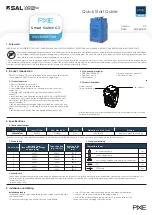
FUJITSU PSWITCH
User’s Guide
126
December/2018
3.1.9.9.5.
Host Interfaces
If routing is globally disabled, the router will not forward packets between routing
interfaces. Each routing interface can act as a host interface, receive packets whose
final destination is the router itself, and send locally generated packets.
3.1.9.9.6.
Unnumbered Interface Support for IPv4
This product supports the option of not numbering a specific IP interface with IPv4.
Unnumbered interface saves IPv4 address space, it is convenient when the
adjacency is temporary and it is not easy to set the IPv4 address in the same
subnet to the adjacent interface. OSPF adjacencies can be created on the
unnumbered interface by configuring OSPF point-to-point operation on the
interface. Running OSPF in unnumbered point-to-point mode eliminates the need
to configure neighbors to enter the same IPv4 subnet. Both iBGP and eBGP are
supported for IPv4 on the unnumbered interface.
Unnumbered IP interfaces are for router-to-router links, not for
router-to-host links.
The implementation of the unnumbered interface follows the industry standard
practices and guidance described in RFC 5309. Each routing interface can be
borrowed from an IP address from the loopback interface and can be used for all
routing activities. The IP unnumbered function was originally developed to avoid
wasting the entire subnet on a point-to-point serial link.
3.1.9.9.7.
Proxy ARP
Proxy ARP provides the routing interface with the ability to respond to ARP requests
to another network device. The router can impersonate its identity and accept the
packet. Packets are routed by routers to their intended destinations.
In actual use, proxy ARP can help network devices on the LAN reach the remote
LAN without configuring a static route or default gateway.
3.1.9.10.
Default Routes on Management Interfaces
When the router is learning the default route of the routing interface, since only
the default route of the routing interface is installed in the IP stack routing table,
the router can not route packets to an IP address that normally arrives using the
default route of the service interface or network port.
I
















































